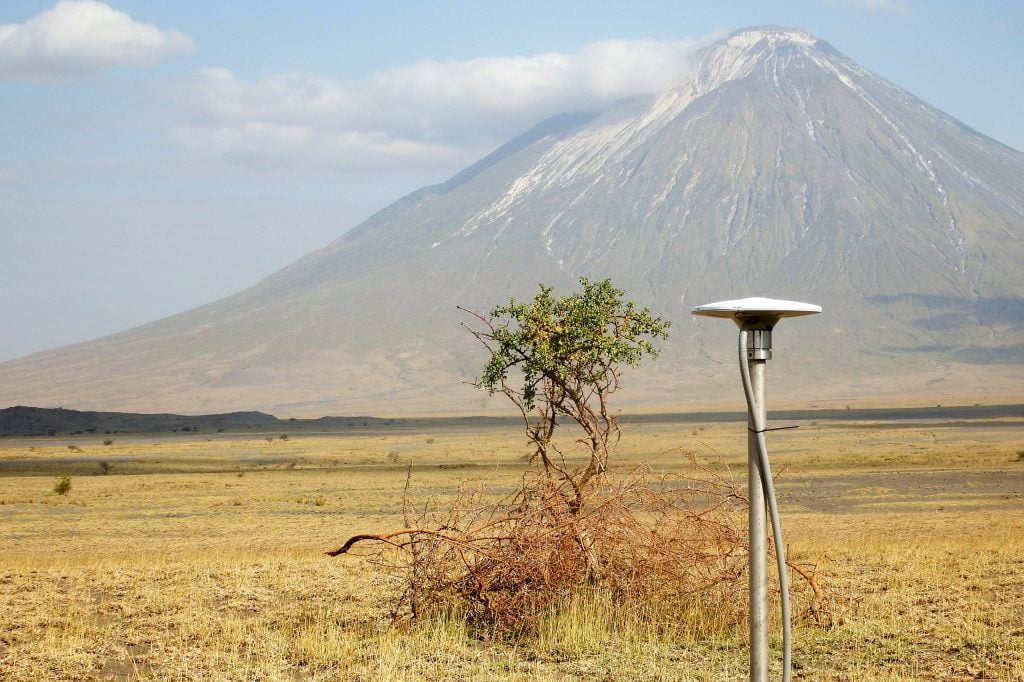 Positioning sensor located at the base of the Ol Doinyo Lengai (The Mountain of God), an active volcano in Tanzania. Photo courtesy of Joshua R. Jones.
Positioning sensor located at the base of the Ol Doinyo Lengai (The Mountain of God), an active volcano in Tanzania. Photo courtesy of Joshua R. Jones.
- Sarah Stamps, an assistant professor in Virginia Tech’s Department of Geosciences in the College of Science, has received a five-year grant worth $625,000 from the National Science Foundation (NSF) to investigate the role volcanoes play in early phase continental rifting — the process in which two plates move apart and stretch the continental crust — at the Natron Rift in Tanzania.
The Earth’s surface is composed of more than 56 tectonic plates that are constantly in motion. They fit together like puzzle pieces to form a hard shell around the Earth’s interior. After billions of years of slowly moving, the interactions between tectonic plates created the geologic formations we see today, such as volcanoes, mountain ranges, valleys, and faults.
Due to a lack of observations specific to volcano-tectonic interactions, the role of volcanoes in early phase continental rifting remains unclear. Stamps and Elifuraha Saria, a collaborator at Ardhi University in Tanzania, hope to fill in these knowledge gaps.
“The Natron Rift is the best place in the world to study volcano-tectonic interactions during early phase rifting,” Stamps said. “You can’t find another place on Earth where you have early phase rifting and a volcano right next to a border fault. The main reason we haven’t understood the role of volcanism in early phase rifting is because the Natron Rift has yet to be studied with the techniques that we’re going to use.”
Next summer, Stamps and her team of researchers will travel to the Natron Rift in the East African Rift System in Tanzania to collect GPS field data. By using GPS to measure surface motions, they will quantify how the Earth’s surface is moving both vertically and horizontally on the volcano and on the surrounding areas within the rift valley.
In addition to taking measurements, Stamps will employ a suite of datasets comprising geochemical data, seismic data and gas measurements. She will also use open access data from a network of GPS stations she deployed between 2016 to 2018 to observe the volcano and develop computational models to better understand how a deformation of the volcano influences movement along the border fault. These models will also further the understanding of volcanic eruptive processes.
“Part of the broader impacts will be using real-time GPS data that comes from the volcano,” Stamps said. “Scientifically, we expect these results to inform volcanic eruptive processes and early phase continental rifting processes. We’ll be using independent data to compare with model predictions of volcanic eruptions.”
The grant will also fund an outreach component designed to engage students, especially underrepresented groups, in geosciences. Stamps will reach K-12 students by working with existing summer camps at Virginia Tech, such as the Black College Institute, to teach students about volcanic hazards and how to use GPS measurements to study earth sciences.
Stamps will also provide training and research opportunities for both undergraduate and graduate students. Part of the outreach components involves training undergraduate students from Hampton University in data analysis.
“I’m thrilled about the entire project,” Stamps said. “It builds upon a project I started in 2015 to develop a volcano observatory in Tanzania, so I’m excited about continuing that project and really expanding it to encompass more scientific investigations and education.”
— Written by Rasha Aridi of the Virginia Tech Fralin Life Sciences Institute


